Potatoes have many different types of scab, which are difficult to treat, because they all appear after harvesting. Yield losses, of course, are not as great as with other diseases and such tubers are quite suitable for food. Probably for this reason, summer residents do not pay special attention to the treatment of scab on potatoes.
| Content:
|
Causes of scab on potatoes
Scab appears more often on potatoes in dry and hot summers, although some varieties of the disease affect tubers with severe waterlogging. Other factors.
- Application of fresh manure causes a strong spread of the disease during storage.
- Application of increased doses of nitrogen fertilizers.
- Deoxidation of a potato plot in spring.
In general, scab appears more often on alkaline soils than on acidic soils. Therefore, acidic soils (pH 4.8 and above) are not deoxidized. Potatoes grow well on them. If the soil is alkaline and the disease manifests itself very strongly, then the next year each hole is spilled with a solution of boric acid or a weak solution of potassium permanganate to reduce the alkalinity.
Description of types of scab and ways to combat it
There are 5 types of the disease, which are caused by different pathogens. But what they all have in common is that the disease manifests itself most strongly during storage; sores appear on the peel.
Common scab
The causative agents are actinomycetes. It affects tubers, sometimes roots and stolons. A whitish cobwebby coating appears on the tubers during storage. It mainly affects the eyes. Dry ulcers of a brownish-rusty color appear on them, pressed into the peel. Over time they may crack. The diameter of the ulcers is from 2 mm to 1 cm.
The eyes are dying. Potatoes lose their germination capacity and their commercial quality deteriorates. Often the ulcers merge, forming a continuous flaky surface.
Common scab appears more often on plots that have not been used for potatoes for 4-5 years.
Favorable conditions are severe drought, soil temperature 24°C and above, pH more than 5.5. The shelf life of tubers is reduced, and commercial quality is reduced. With severe damage, the taste deteriorates slightly.
The infection is transmitted through planting material and soil. The spores are not stored in storage, but the mycelium develops.
Common scab can manifest itself in 4 forms:
- convex
- flat
- mesh
- deep.
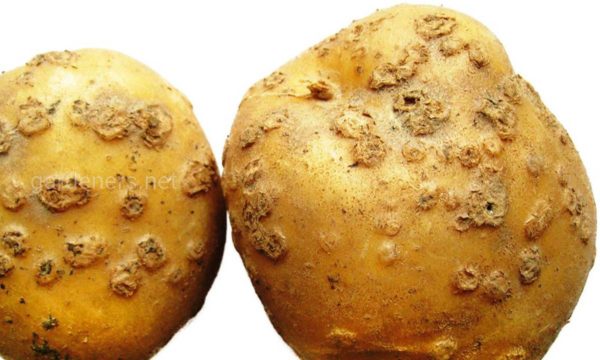
Pictured: Convex shape
Convex shape. It first appears in the form of small depressions, and then forms tubercles in the form of scabs on the peel. The scabs are located mainly near the eyes.

Flat shape
Flat shape. This form is without tubercles. Small hardened areas or scratches appear on the skin that are the same color as the tuber.
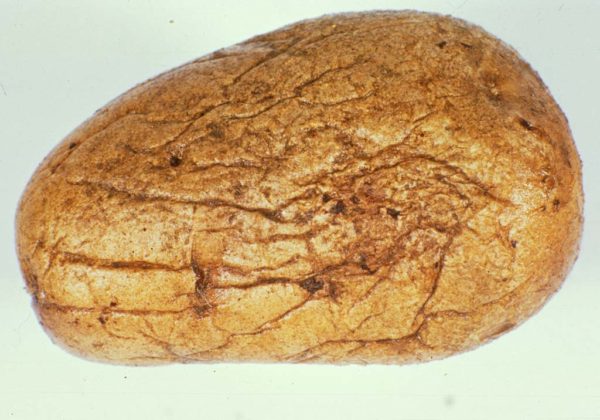
Mesh shape
Mesh form. Shallow grooves and scratches going in different directions. They are mainly located on the half of the tuber where the eyes are.
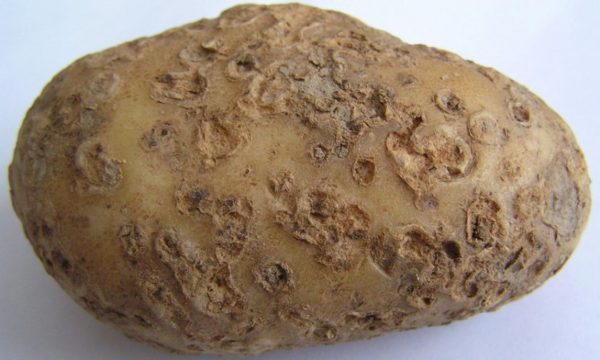
Pictured: Deep form
Deep form. Quite large depressed ulcers form, and the skin on their surface cracks. The pulp on the surface of the sores is soft and loose, but not wet.
Methods for combating common scab
Before taking any measures, determine the acidity of the soil. At pH above 5.5, light alkalization is carried out. Potatoes grow well at a pH of 4.8-5.5. Therefore, lowering the pH does not affect yield, but significantly reduces the spread of common scab.
- In the fall, add manure or peat. They slightly acidify the soil.
- Physiologically acidic fertilizers are used instead of alkaline and neutral ones: double superphosphate, potassium sulfate, nitrophoska, ammonium sulfate, etc.
- Regular watering of potatoes during drought.
- Growing varieties resistant to disease. The early and mid-season varieties are mainly resistant to common scab: Zhukovsky, Detskoselsky, Lugovskoy, Rozara,
- Store at 1-3°C.
When a crop is grown for many years in one place, ordinary scab appears infrequently.
An excellent prevention is treatment with Trichodermin. Before planting or storing the potatoes, soak them in the drug solution for 15 minutes and then dry them.
Rhizoctoniosis or black scab
Black scab is very common in the Non-Black Earth regions of the country, as well as in the Far East. In addition to potatoes, it damages other vegetable crops. On potatoes, tubers, stolons, and in some cases stems are affected. The causative agent is a fungus from the class of basidiomycetes.
Seed material is affected. When planting diseased tubers, the seedlings die. Rhizoctoniosis can be noticed even during harvesting: there are black spots on the potatoes that look like pieces of stuck earth. They are easily scraped off, but during storage they continue to develop and affect the eyes. The spots turn into weeping sores of an earthy or black color, 1-3 cm in size. Sometimes a black mesh appears on the top of the potato (where there are more eyes). The affected tissues rot.
Earthy-brown or black spots appear on stolons, roots and stems, gradually turning into sores. Seedlings affected by rhizoctonia become covered with earthy spots, break and die. Some sprouts do not germinate at all. The germination rate of tubers is low.
Favorable factors are high soil moisture and temperature 17–19°C. The main sources of infection are soil and tubers.
Rhizoctonia blight is most pronounced on poor, poorly fertilized, heavy soils. On manured, light soils, the disease manifests itself weakly.
Measures to combat black scab
Potatoes are planted only in well-warmed and dry soil. In damp soil, tubers are very susceptible to black scab.
- The most effective measure is to grow resistant varieties: Nevsky, Penza skorospelka, Bronnitsky, Lasunak, Aspiya.
- The use of green manure after harvesting: oilseed radish, vetch-oat mixture, help in the fight against scab.
- Before planting and after harvesting, treat potatoes with biological preparations Baktofit, Agat-25, Planriz or Binoram.
In crop rotation on poor soils, manure is applied to the plot at least a year before planting potatoes, 2-4 buckets per m2. When continuously growing crops in the fall, add rotted manure or humus 1-2 buckets per m2.
Silver scab
Potatoes are affected during storage, closer to spring, although signs of the disease are observed already during harvesting. The tubers have grayish or slightly silvery spots pressed into the skin, 2-6 mm in diameter. The concentration of spots is greater at the end that was attached to the stolon.
Closer to spring, diseased tubers acquire a silvery sheen. The spots are pressed deeper into the peel, and black dots appear underneath. The evaporation of water from the surface of the tuber increases, and it becomes lighter.
When germinating diseased seed material, it produces very weak thread-like sprouts that easily break off, and when planted, the seedlings are weak, sparse, and often die quickly.
Silver scab begins to actively develop if the temperature in the storage is 3°C or higher and the humidity is more than 90%. The commercial quality and taste of potatoes are noticeably reduced.
Varieties of foreign selection are more sensitive to the disease than domestic ones.
How to deal with silver scab
- The storage temperature during the entire storage period should be 1-3°C and humidity 86-88%.
- Before harvesting for storage, potatoes are dried in the open air for at least 4 hours, but preferably 3-4 days.
- Sorting and removal of diseased tubers.
- During vernalization, potatoes that produce weak sprouts are removed.
To prevent the disease, the soil is kept in a loose state, hilling up as necessary.
Powdery scab
The disease is very common in the Non-Chernozem and North-Western regions. Favorable conditions are high rainfall and high soil moisture, so intense outbreaks are observed in rainy years. It affects tubers, stolons, roots and the lower part of stems after sprinkling them with earth during hilling.
Growths of various shapes and sizes form on all affected organs. At first they are whitish, gradually darkening. The growths are filled with mucous contents. Gradually they open, the mucus flows out and infects neighboring tubers. The exposed growths are brown-red in color and form deep ulcers (pustules). Their edges turn outward, and in the center a powdery whitish mass is visible - sporulation of the pathogen. The size of the ulcers is 5-7 mm.
The presentation and shelf life of diseased tubers decreases, and they gradually dry out. When roots and stolons are damaged, the yield decreases, and sometimes tuberization does not occur. When the stems are damaged, rot very quickly joins the scab and the bush dies.
In rainy years, crop losses during storage are significant. It spreads especially strongly on heavy, long-drying soils. The scab pathogen persists in the affected tubers and soil, so the land in which potatoes are grown also needs treatment.
How to prevent the disease
Powdery scab spreads more strongly in acidic soils. Therefore, when the disease spreads strongly, it is limed.
In heavy and damp soils, potatoes are grown in ridges. When the disease spreads strongly, sparse plantings (80-85 cm) are made for better ventilation. Prevent soil compaction by loosening after each rain. If diseased plants are found, they are immediately removed from the plot.
Maintain air humidity in the storage no more than 90%. If diseased tubers are detected, the potatoes are sorted and dried during the day at a temperature of 10-15°C.
Lumpy scab
It only affects tubers. It appears during storage several months after harvesting. Small tubercles appear on the tuber, gradually merging with each other. The peel begins to peel off. Sometimes 5-8 tubercles grow together, forming a spot, as with late blight, but there is no darkening or destruction of the pulp under the skin. The tubercles have the same color as the potatoes, but gradually darken. Their edges are pressed into the peel, and the middle is convex.
The disease is widespread in the northern and northwestern regions. Sometimes found in the north of the non-chernozem zone. It affects the eyes. When planting, germination rate decreases by more than 30%. It spreads strongly on unfertilized soddy-podzolic and sandy soils. When adding organic matter, the disease weakens somewhat.
Favorable development factors are a temperature of 12-16°C.In storage, the disease develops because the threshold for stopping the development of the pathogen is 1.5°C. The disease persists in the soil and infected tubers.
Protective measures
- Before harvesting, the harvest is dried under a canopy for 3-5 days.
- Store the harvest in a well-ventilated area so that there is always a flow of fresh air.
- The temperature in the storage should be 1-2°C.
In hot and relatively dry summers, lumpy scab practically does not appear.
How to treat tubers for scab
Since potatoes become infected in the ground, and the full picture of the disease appears only in storage, all therapeutic measures are preventive. They are aimed at reducing the incidence and spread of infection during the growing season. To prevent potato infection in the ground, scab treatment begins even before planting the tubers by treating the seed material.
Maxim Dachnik
The seed material is soaked in the working solution for 15 minutes or the tubers are sprayed 20-30 minutes before planting. The drug gives an excellent effect on slightly acidic soils (pH 5.5-5.8). After etching, only a few diseased specimens are found. Before harvesting for storage for preventive purposes, potatoes are also sprayed with this preparation. It should not be eaten for 25 days.
After treatment, scab practically does not spread in storage facilities. Maxim Dachnik is effective against all types of scab.
Club shield
An insectofungicide that protects the crop from diseases, as well as from gnawing and sucking pests, both the aboveground part of the plant and the tubers. Potatoes are processed immediately before planting by spraying the planting material. After processing, the potatoes are planted immediately. The drug is not stored.The remaining solution can be used to treat the roots of seedlings. The tuber shield is especially effective against common scab and rhizoctonia.
Prestige
Can be processed in two ways:
-
- 7-10 days before planting. The seed material is soaked in the working solution for 30 minutes, after which it is thoroughly dried, and then again laid out for vernalization;
- processed on the day of planting. The potatoes are sprayed with the working solution or soaked in it for 20 minutes. Then the tubers are dried until a red shiny film forms on them and only then planted.
Trichodermin, Fitosporin
Biological products are used on slightly acidic soils (pH 5.4-5.0) with a slight spread of the disease. The potatoes are soaked in the drug solution for 20-30 minutes, slightly dried and planted. They are also used to prevent the spread of infection in storage. Before harvesting for storage, the tubers are sprayed or soaked in a solution for 20-30 minutes, after which they are thoroughly dried and stored.
If the infection spreads during crop storage, fumigants are used in storage facilities.
Whist checkers
Fumigation is carried out immediately after harvesting potatoes for storage. The protective effect, provided the storage temperature is maintained, lasts 6-8 months. If the temperature in the storage increases and the disease appears, repeated fumigation is carried out, but not earlier than 3 months after the first. Whist is much safer than sulfur bombs and is used in rooms already filled with crops. The checker is safe for people and animals. Combustion occurs within 24 hours in a hermetically sealed room. After this, the storage is ventilated.
If potatoes are stored in non-residential premises, then fumigation is the best method to prevent infection.If potatoes are stored at home, then fumigants are not used. The harvest is sorted once a month. Diseased tubers are consumed first. Scab is not dangerous to humans, and although the commercial quality of potatoes is reduced, they can be eaten.
Folk methods of struggle
To combat potato scab, many gardeners also use traditional methods. Alternating potatoes and meadow grasses helps reduce the incidence. If the plot is large enough, then it is marked out into strips 0.7-0.8 m wide. Potatoes are planted on even stripes, and lawn grass on odd strips. The grass is periodically mowed and left as mulch.
You can also make two-line strips 1-1.2 m wide. On even-numbered stripes, potatoes are planted in two rows in a checkerboard pattern; on odd-numbered stripes, grass is sown. The next year the stripes are changed.
This strip cultivation reduces potato scab infestation by 40%.
Prevention
Scab on potatoes (except for the powdery form) spreads greatly on alkaline and near-neutral soils. In addition, on sandy soils the crop suffers more than on loams. Hence the preventive measures.
- Reducing soil alkalinity. If the disease spreads strongly, the pH can be safely reduced to 5.1-4.9. Potatoes grow well in acidic soil. For alkalization, add pine litter, peat, or water the plot with a pink solution of potassium permanganate. If the pH needs to be reduced slightly, then physiologically acidic fertilizers (magnesium sulfate, double superphosphate) are applied.
- If the powdery form of the disease is very widespread, then the pH is slightly increased (5.3-5.5) by adding ash to the hole when planting. It is not recommended to use lime, since the crop does not tolerate it well.The powdery form spreads more strongly on acidic soils.
- Reduction of nitrogen background on the plot. In the fall, rotted manure is added. Semi-rotted and, especially, fresh ones cannot be introduced, this leads to a strong spread of tuberous rot. If fertilizing is necessary, only phosphorus and potassium fertilizers are applied, nitrogen fertilizers are excluded.
- Maintaining crop rotation. It is advisable to observe at least a two-field crop rotation. Good predecessors are pumpkin crops (zucchini, pumpkin, cucumbers) and cabbage crops. It is unacceptable to plant potatoes after nightshades (tomatoes, peppers, cucumbers).
Scab spreads less on fertile soils. Therefore, to increase its fertility, rotted manure is added annually in the fall.
Green manure against scab
One way to treat infected soil is to plant green manure. Green manure not only enriches the soil with nutrients, but also prevents the spread of diseases, and even some pests and weeds. In addition, for soils of different mechanical composition and acidity, their own green manures are preferred.
Rye. Well suited for acidic soil, although it can be grown in any soil. Rye prevents the development of many pathogens, including scab. In addition, it displaces wheatgrass from the plot and reduces the number of wireworms.
Oats. Clears the soil of scab spores, as well as various rots. It also reduces the number of nematodes in the field.
White mustard. Prevents the spread of scab and rot spores in the potato field. Also, the essential oil contained in it repels wireworms and the Colorado potato beetle well. Mustard is not afraid of cold and germinates well at 1-3°C, so in the northern regions and middle zone it can be sown until mid-September.
Oilseed radish. It belongs to the cruciferous family, so it does not grow well in acidic soils. On slightly acidic and neutral soils, it improves the quality of the soil and reduces the content of pathogens in it.
Potato varieties resistant to scab
At present, no varieties completely resistant to scab have been developed. There are varieties that are less susceptible to the disease than others. This is due to the fact that there are varieties of scab caused by different pathogens, so it is difficult to obtain varieties that are resistant to various pathogens of this disease.
Alyona. Russian early ripening variety. Low susceptible to common scab, rhizoctonia and late blight. Can grow on any soil.
Granada. Middle late German variety. Very resistant to scab, late blight, and drought.
Lasunok. A variety of Belarusian selection. Moderately resistant to scab. During drought, 10% of the tubers are affected (although the variety itself does not tolerate drought well). In humid summers the disease is practically absent. Lasunok is also very resistant to the Colorado potato beetle. The pest prefers other varieties. Suitable for cultivation in the Non-Black Earth Region.
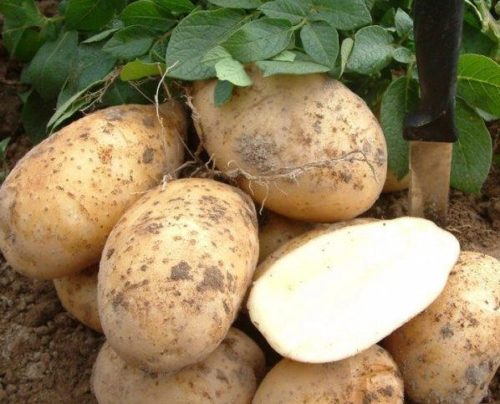
In the photo is the variety Lasunok
Typhoon. A very resistant mid-early Polish potato variety. Resistant to scab and late blight of tops, but susceptible to late blight of tubers. Designed for cultivation in risky farming areas. Recovers from frost and hail. Drought resistant.
Gypsy. It has a very thin purple peel, which is why it is easily damaged. Resistant to scab and gray rot.
American. The oldest variety of American selection, grown in the USSR, and even now widely distributed in the post-Soviet space. The variety was bred in 1861 in the USA. Very resistant to scab, but severely affected by late blight.
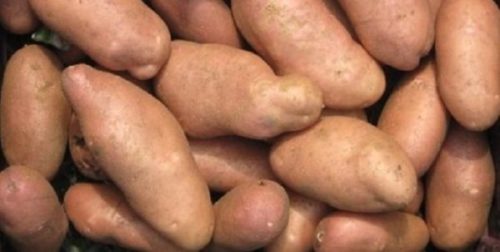
The photo shows the American variety
Kubanka. An early variety of Russian origin. It is resistant to scab and, due to its rapid ripening, is practically not affected by late blight. It has an excellent taste, which is usually not characteristic of early varieties.
Rosara. German early variety. Resistant to scab and late blight.
Openwork. Mid-early variety of Russian selection. It is resistant to scab, but in wet years it is affected by late blight.
Master. Mid-season Russian variety. Resistant to common scab and rhizoctonia, moderately resistant to late blight of tubers. Barin is affected above average by other types of scab.
Ermak improved. Brought to the USSR. Early ripening, intended for cultivation in Western Siberia. It tolerates heat well and is relatively resistant to scab.
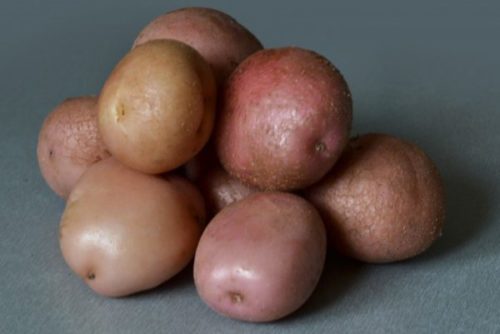
In the photo, Ermak improved
Domestic varieties under the same growing conditions are affected by the disease less than imported ones. This is due to the better adaptability of the variety to local conditions. In the USSR and Russia, all varieties were zoned for growing in certain climatic conditions.
Conclusion
Potato powder is not as harmless a disease as it seems at first glance. It can destroy up to 30% of the entire crop. But when preventing the disease, there is one undoubted advantage: the same drugs can be used to treat all types of disease, which greatly facilitates the fight against scab.
Even resistant varieties are treated for prevention when planting.
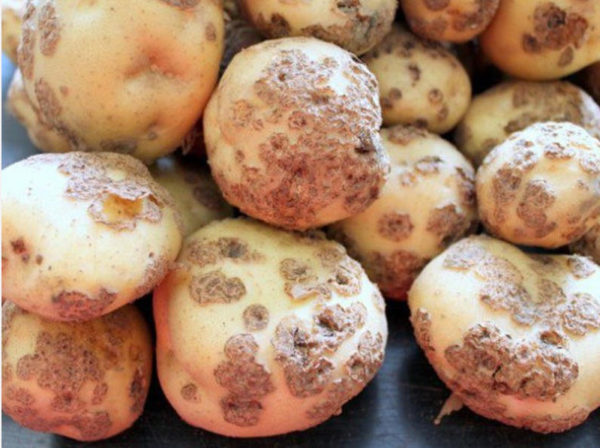
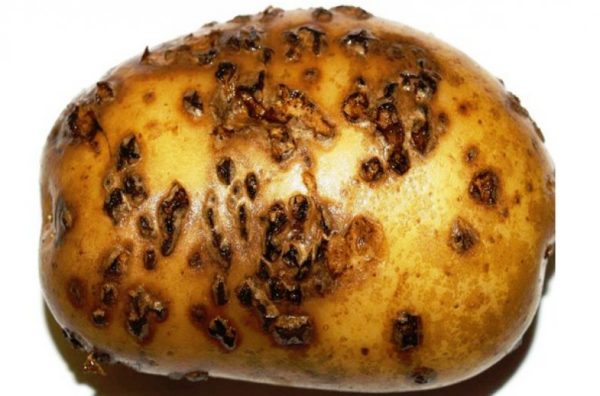
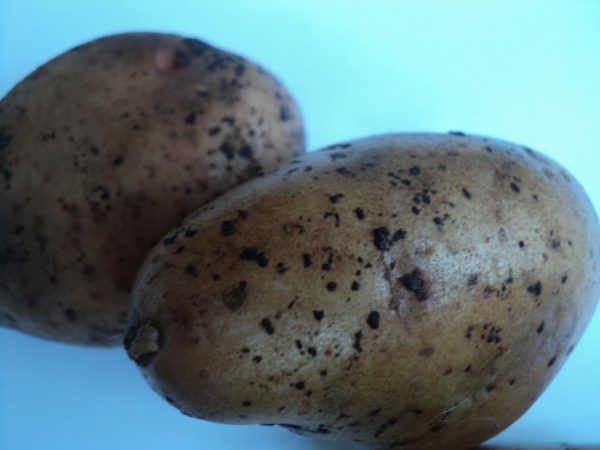
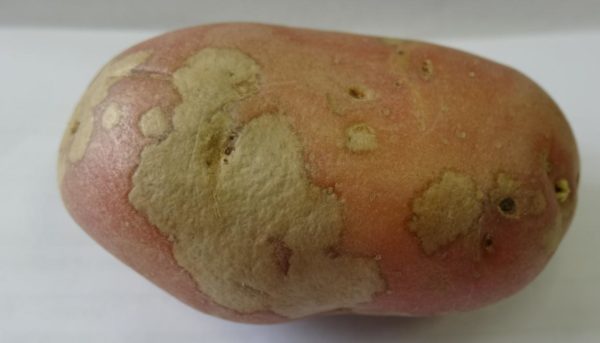
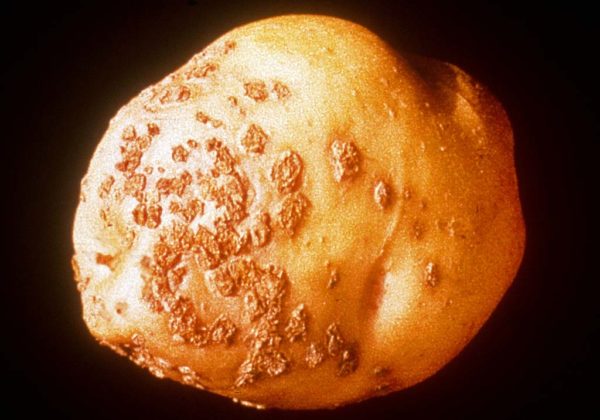

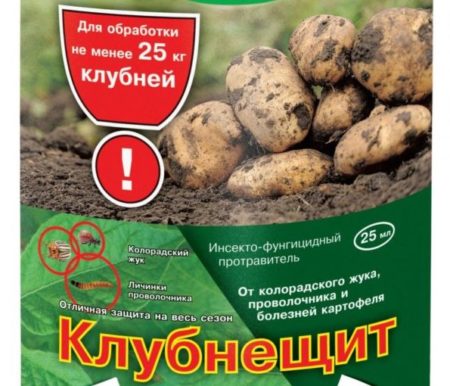
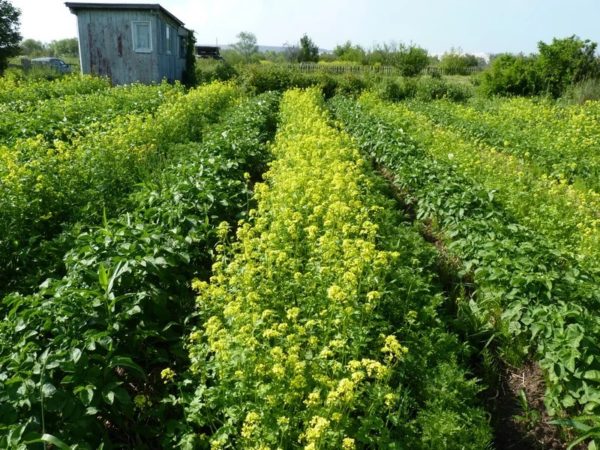



 CUCUMBERS NEVER GET SICK, I'VE BEEN USING ONLY THIS FOR 40 YEARS! I SHARE A SECRET WITH YOU, CUCUMBERS ARE LIKE THE PICTURE!
CUCUMBERS NEVER GET SICK, I'VE BEEN USING ONLY THIS FOR 40 YEARS! I SHARE A SECRET WITH YOU, CUCUMBERS ARE LIKE THE PICTURE! You can dig a bucket of potatoes from each bush. Do you think these are fairy tales? Watch the video
You can dig a bucket of potatoes from each bush. Do you think these are fairy tales? Watch the video
 How our fellow gardeners work in Korea. There is a lot to learn and just fun to watch.
How our fellow gardeners work in Korea. There is a lot to learn and just fun to watch. Eye trainer. The author claims that with daily viewing, vision is restored. They don't charge money for views.
Eye trainer. The author claims that with daily viewing, vision is restored. They don't charge money for views. A 3-ingredient cake recipe in 30 minutes is better than Napoleon. Simple and very tasty.
A 3-ingredient cake recipe in 30 minutes is better than Napoleon. Simple and very tasty. Therapeutic exercises for cervical osteochondrosis. A complete set of exercises.
Therapeutic exercises for cervical osteochondrosis. A complete set of exercises. Which indoor plants match your zodiac sign?
Which indoor plants match your zodiac sign? What about them? Excursion to German dachas.
What about them? Excursion to German dachas.
Symptoms of silver scab: the surface of the tuber becomes wrinkled, the affected areas have a silvery tint, this is especially noticeable on varieties with red skin. Potatoes with white skins are difficult to peel. During storage, the gray-brown spots increase in size and may be slightly depressed. Black formations appear under the skin. Diseased tubers germinate poorly and produce low yields. Black scab (rhizoctoniosis). Develops at high humidity and air temperature of about 17°C. One of the most dangerous potato diseases, it can occur at any stage of growth. A rainy, cold spring leads to the death of bushes. Potato losses from rhizoctonia blight amount to 20-25%.